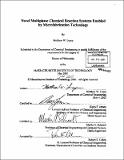| dc.contributor.advisor | Klavs F. Jensen and Martin A. Schmidt. | en_US |
| dc.contributor.author | Losey, Matthew W | en_US |
| dc.contributor.other | Massachusetts Institute of Technology. Dept. of Chemical Engineering. | en_US |
| dc.date.accessioned | 2005-08-23T21:53:37Z | |
| dc.date.available | 2005-08-23T21:53:37Z | |
| dc.date.copyright | 2001 | en_US |
| dc.date.issued | 2001 | en_US |
| dc.identifier.uri | http://hdl.handle.net/1721.1/8634 | |
| dc.description | Thesis (Ph. D.)--Massachusetts Institute of Technology, Dept. of Chemical Engineering, 2001. | en_US |
| dc.description | Includes bibliographical references (p. 237-251). | en_US |
| dc.description.abstract | Advances in MEMS (micro-electromechanical systems) have enabled some of the "Lab-on-a-Chip" technologies and microfluidics that are pervasive in many of the current developments in analytical chemistry and molecular biology. Coinciding with this effort in micro-analytics has been research in chemical process miniaturization -- reducing the characteristic length scale of the unit operation to improve heat and mass transfer, and ultimately process performance. My research has involved the design and fabrication of novel chemical reaction systems using MEMS and microfabrication methods (photolithography, deep-reactive-ion etching, thin-film growth and deposition, and multiple wafer bonding). Miniature chemical systems provide the opportunity for distributed, on-demand manufacturing, which would eliminate the hazards of transportation and storage of toxic or hazardous chemical intermediates. Reactions that are particularly suitable for miniaturized chemical systems are those that are fast and involve toxic intermediates: the controlled synthesis of phosgene is such a reaction and has been demonstrated in a microfabricated packed bed reactor. Owing to the high surface-to-volume ratios, micro chemical systems also have the potential to make improvements in process performance through enhanced heat and mass transfer. | en_US |
| dc.description.abstract | (cont.) Heterogeneously catalyzed gas-liquid reactions have been performed in the microfabricated reactors and have been shown to have mass transfer coefficients several orders of magnitude larger than their industrial-scale counterparts. Multiphase reactions are often hindered by mass-transfer limitations owing to the difficulty in transporting the gaseous reactant through the liquid to the catalytic surface. The microchemical device has been designed to increase the interfacial gas-liquid contacting area by promoting dispersion and preventing coalescence. Microfabrication allows the design of reactors with complicated fluidic distribution networks, staggered arrays of microstructural features to promote mixing, and the integration of sensing and temperature control. Other uses of microfabrication include the incorporation of porous silicon as a high surface area catalyst support. In all, performing multiphase chemistry on a chip has been demonstrated to have inherent advantages, particularly for those fast reactions that can benefit from improved mixing and mass transfer. | en_US |
| dc.description.statementofresponsibility | by Matthew W. Losey. | en_US |
| dc.format.extent | 251 leaves | en_US |
| dc.format.extent | 23228967 bytes | |
| dc.format.extent | 23228719 bytes | |
| dc.format.mimetype | application/pdf | |
| dc.format.mimetype | application/pdf | |
| dc.language.iso | eng | en_US |
| dc.publisher | Massachusetts Institute of Technology | en_US |
| dc.rights | M.I.T. theses are protected by copyright. They may be viewed from this source for any purpose, but reproduction or distribution in any format is prohibited without written permission. See provided URL for inquiries about permission. | en_US |
| dc.rights.uri | http://dspace.mit.edu/handle/1721.1/7582 | |
| dc.subject | Chemical Engineering. | en_US |
| dc.title | Novel multiphase chemical reaction systems enabled by microfabrication technology | en_US |
| dc.type | Thesis | en_US |
| dc.description.degree | Ph.D. | en_US |
| dc.contributor.department | Massachusetts Institute of Technology. Department of Chemical Engineering | |
| dc.identifier.oclc | 49560131 | en_US |
